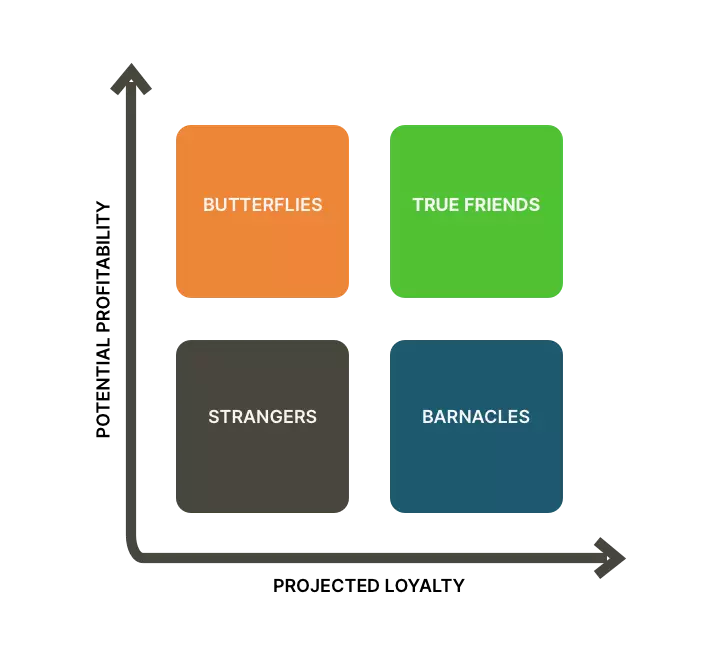It is often thought that a company should acquire as many customers as possible. In the end, the more customers, the more revenue, right?
Well… no, not really.
Not all customers, not even loyal customers, are good customers.
Although it might be surprising, loyal customers can be more unprofitable than some disloyal customers. Therefore, which customers should the company acquire and keep?
The Customer Relationship Groups bring clarity.
In order to fulfil the marketing strategy and capture maximum value from customers, the firm must build the right relationships with the right customers.
In order to do so, the Customer Relationship Groups model can be used. It classifies customers based on their potential profitability for the company and leads to a way to manage the relationships with the different categories of customers accordingly.
This is due to the fact that each group of customers requires a different relationship management strategy.
The four categories of customers according to the Customer Relationship Groups Model are: Butterflies, True Friends, Strangers, and Barnacles. The names of these groups already indicate the specific relationship management strategy required, based on the projected profitability of that group for the business.
These four groups are sorted on the Customer Relationship Groups grid, which has two axes: the projected loyalty on the horizontal axis, involving short-term and long-term customers, and potential profitability on the vertical axis, involving less and more profitable customers.

Strangers offer only low potential profitability, and also little projected loyalty. Why? Because the gap between the company’s offerings and the strangers’ needs is just too large. They simply do not fit the company’s offerings, and consequently are not profitable. So, the relationship management strategy for strangers is rather simple: don’t invest anything in them, which is to say that strangers should be dropped immediately.
Better than strangers are Butterflies for the company. These are at least potentially profitable, although not loyal. What does it mean? Butterflies have needs that fit the company’s offerings, that is, the company’s offerings are in line with the needs of butterflies. But the term butterflies also reveals the negative side of them: like real butterflies, we can enjoy them only for a short while and then they will be gone. Therefore, it is very hard to build a long-term relationship with butterflies. Attempts to do so are rarely successful. So, the relationship management strategy is accordingly: the company should enjoy the butterflies for the moment, as long as they are profitable. In this time, profitable and satisfying transactions should be created, to capture as much value from them as possible in the short time. After that, when they become unprofitable, the firm should stop investing in butterflies.
In contrast to strangers and butterflies, barnacles are highly loyal. However, they are not profitable. Between barnacles’ needs and the company’s offerings, there is only very limited fit, meaning that they make no full, not even large partly use of the firm’s offerings. However, they do it over a long period of time and regularly. An example for barnacles are small customers of a bank who bank regularly, but only in such tiny amounts that the returns generated by them are too low to cover the costs of maintaining their accounts. They are customers, and loyal ones as well, but as said before, that does not mean that they are desirable. Therefore, barnacles may be the most problematic customers of a business, since they are still loyal customers. Therefore, the relationship management strategy calls for attempts to increase their profitability for the firm, e.g. by trying to sell them more, or by raising fees, maybe even by reducing service to them. Yet, if they cannot be made profitable, which will often be the case, barnacles should be dropped. Since they are still loyal customers, this may be highly difficult. In most cases, there is no other way than to actually “fire” them.
Finally, we arrive at True Friends. True Friends are the best customers for any company from all Customer Relationship Groups. Why? In contrast to the three other groups, they are profitable and at the same time loyal. The fit between their needs and the company’s offerings is very strong. As a consequence, the firm should totally focus on acquiring true friends and maintaining relationships with them. The relationship management strategy involves making continuous investments in the relationship to not only satisfy these customers, but to delight them. Then, their base can be nurtured, retained, and in the best, desirable case, be grown, in order to convert the true friends into ‘true believers’. True believers is the maximum value a customer can reach for a company: they come back regularly and spread word about their satisfaction and positive experiences with the company.
Taking these considerations based on the Customer Relationship Groups into account, a company can choose the right relationship management strategy for each group of customers. As a result, it can build the right relationships with the right customers.

Email subscription is available ONLY TODAY (oh, okay, and tomorrow).
Surely, we respect your inbox! Unsubscription works every day.

We’d love to tailor your experience — which of these best describes you?